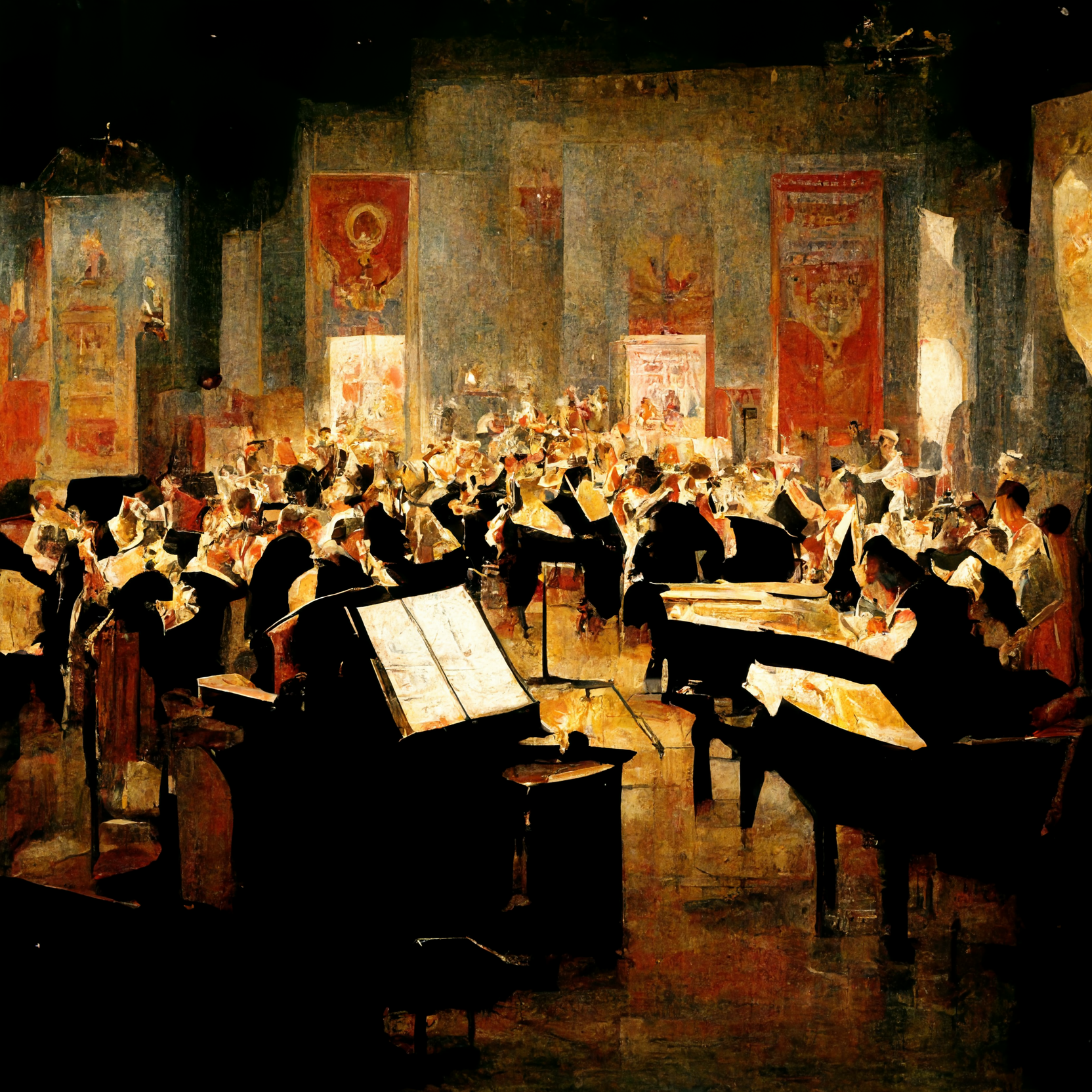Nobutaka Yamaoka made his feature-length directorial debut with “Pickled Punk” in 1993. He has continued working in an experimental style ever since, and his films have screened at numerous festivals including the Berlin Film Festival. He is also involved in the field of science, exploring topics such as the effects of vision on the psyche and the development of various devices. A retrospective of his features was presented at the 2013 Independent Filmmakers Showcase in Los Angeles. His first documentary, “Children who won’t die, Arakawa,” premiered in 2010. “Hooked on the Jomon” and new release “Sentimental” both won Lumiere Japan Excellence Awards. Yamaoka’s latest work is the two-part “Arts for no future!”
AI Patronage Group + Midjourney《Is it the composer’s fault that the performer has only 10 fingers?, CHARES IVES Symphony for full orchestra and choir and three pianos》 2022
What took place in the main hall at Parthenon Tama on December 25, 2022 may have looked like a classical concert. Some in the audience may indeed have experienced it as such, and then simply returned home. Yet, many of those who attended must have, at least for a moment, stared hard at the title of the concert.
“Is it the composer’s fault that the performer has only 10 fingers?”
That may seem like a simple question when skimmed over, but is rather a pointed indication that all the works of art we revere as masterpieces are merely the result of an activity that moves to and from in a very small world with strong restrictions based on specific assumptions.
So would the piece be better if the performer had 20 fingers? Or would music itself change? Is the conventional style of criticism sufficient? Questions begin to arise, one after another. And the doors (or perhaps pitfalls) that these questions open lead to the fundamental question that all people involved in art must eventually face: the question that, if ignored, leads to nothing but the continued, foolish production of comforting entertainment.
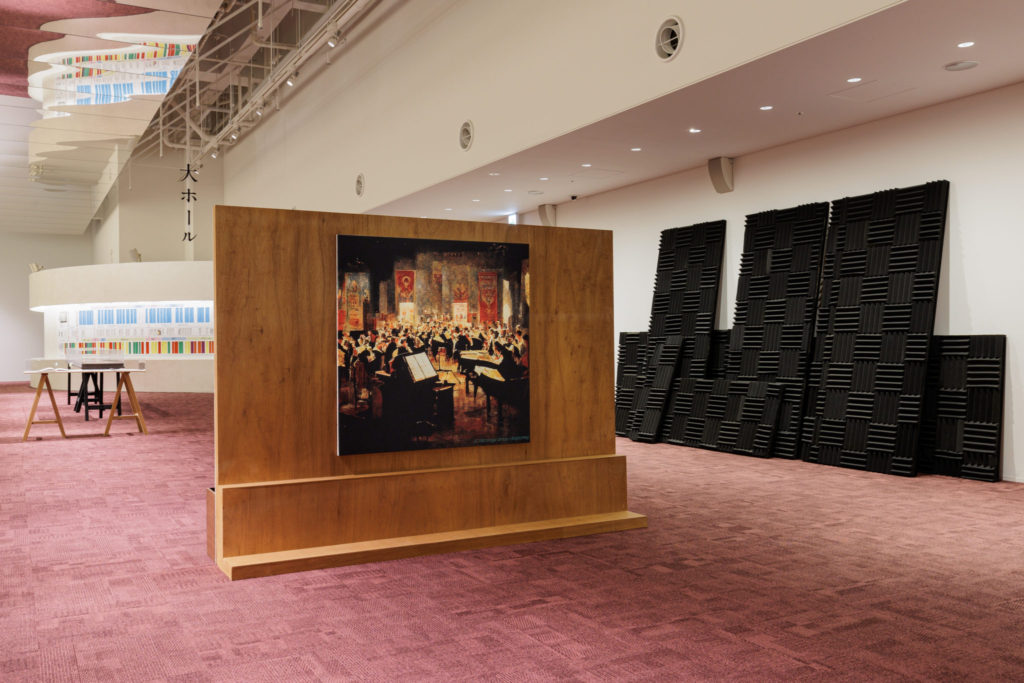
Installation view Artificial Intelligence Art and Aesthetics Exhibition 2022 (Foreground, center) AI Patronage Group + Midjourney《Is it the composer’s fault that the performer has only 10 fingers?, CHARES IVES Symphony for full orchestra and choir and three pianos》 2022 (Right) Artificial Intelligence Art and Aesthetics Research Group《The Reverse Cocktail Party Effect 2022》 (Far and, to the left) Artificial Intelligence Art and Aesthetics Research Group 《Chronological Table of Artificial Intelligence Art and Aesthetics》 (2017-2022) Photo by Masaru Kaido, Courtesy of Artificial Intelligence Art and Aesthetics Research Group
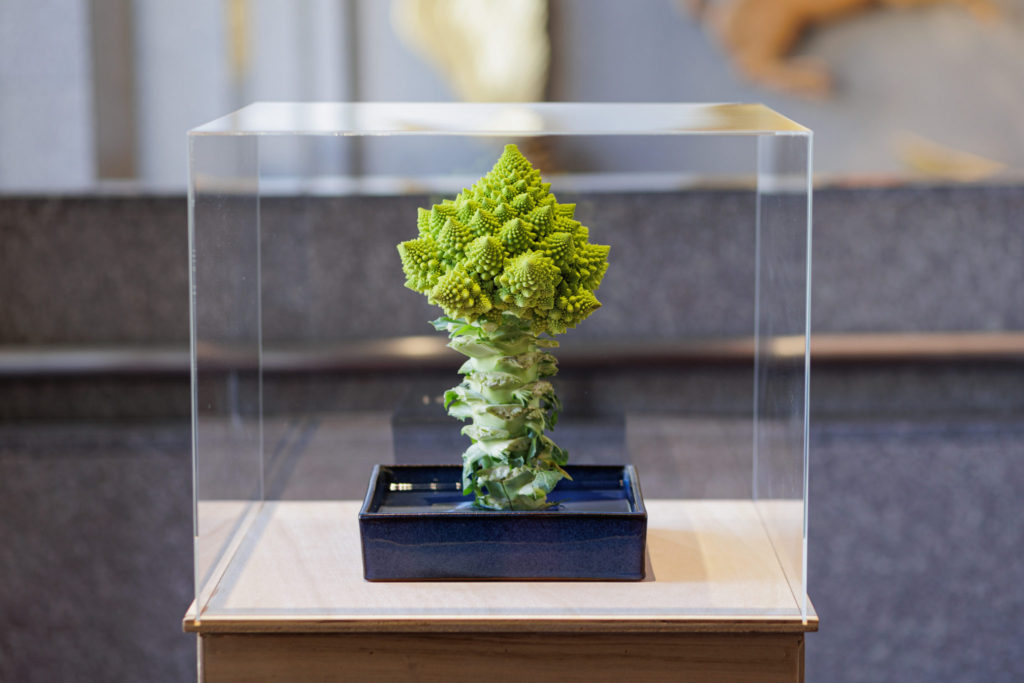
Installation view Artificial Intelligence Art and Aesthetics Exhibition 2022 Senjin Kusakari《Romanesco Fibonacci Sequence》2022 Photo by Masaru Kaido, Courtesy of Artificial Intelligence Art and Aesthetics Research Group
The event was organized by the Artificial Intelligence Art and Aesthetics Research Group (AIAARG). This group was established to study art made by using artificial intelligence (AI), which has received increasing attention in recent years…no, not at all—its focus is actually the aesthetics and art created by a self-aware AI of its own volition. That’s right: as of today, no such AI exists on Earth, nor is one likely to emerge for the foreseeable future. However, the world is filled with sci-fi fantasies and other speculation predicting that such a thing will eventually be developed. Therefore, the title of this concert haunted the audience like a specter, both during the performance and in the foyer between acts, driving home the realization that the art we have taken for granted is barely floating on a fragile promise. As can be inferred from the above, the concert was not just a musical performance but also an art exhibition, as in the foyer visitors could view objects with fractal structures that were hard to distinguish from either plants or machines, as well as AI-made paintings, which became popular last year. One could even argue that the event itself was a work of art, and only when appreciated as such could one get a sense of the AIAARG’s intentions.
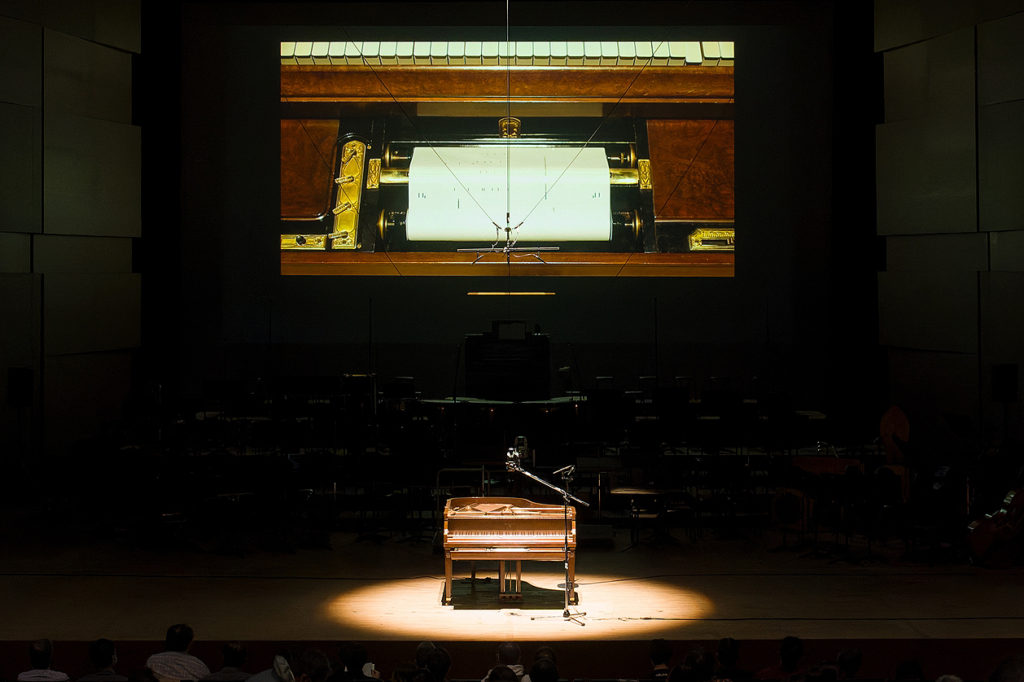
Performance scene Artificial Intelligence Art and Aesthetics Exhibition 2022 Conlon Nancarrow《Study for Player Piano》 Photo by Hitoshi Iwakiri, Courtesy of Artificial Intelligence Art and Aesthetics Research Group
The aforementioned title borrows the words of the American composer Charles Ives, whose Symphony No. 4 made for the main course of the concert. Being a symphony, a full orchestra with choir is to be expected, but the astonishing thing is that the work requires not only three conductors but three pianos, and in addition to electronic instruments, there were two separate groups of performers in the stands. The symphony naturally attracts attention because of its extraordinary quality, but the program leading up to it scrupulously demonstrated that this event was no ordinary concert. I’m not referring to the various works of art displayed in the foyer, but rather to Conlon Nancarrow’s “Studies for Player Piano” that opened the concert. This was a brilliant configuration that made one aware of the artistic quality of the event. There were no people on stage, with the self-playing piano just solemnly spitting out music and the audience simply staring at it. Although the piece being performed was not written by an AI, the piano gradually started playing in a way obviously impossible for humans to replicate, and the sight of the audience being given no choice but to continue taking in this inhuman activity made me imagine the fate of humanity when, in the near future, we begin to trust AI to make major decisions for us and accept its pronouncements with gratitude. It felt like an invitation to the masochistic pleasure of surrendering one’s humanity to something else.
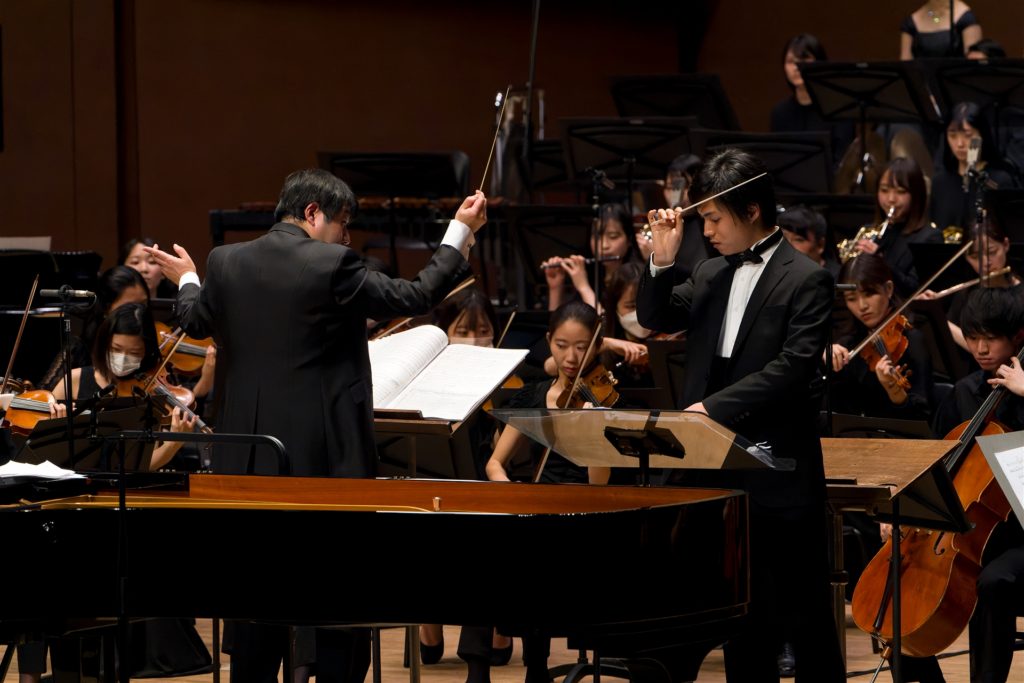
Performance scene Artificial Intelligence Art and Aesthetics Exhibition 2022 Charles Ives《Symphony No. 4》 (Left) Conductor: Masakazu Natsuda (Right) 1st assistant conductor: Yuki Urabe Photo by Hitoshi Iwakiri, Courtesy of Artificial Intelligence Art and Aesthetics Research Group
The player piano finished its performance and was greeted with puzzled applause. How can human beings (at least for now) applaud a machine without consciousness? In the future, however, with the emergence of art created by a sentient AI, we may not only applaud, but prostrate ourselves and worship without hesitation. Before the question of beauty is even raised, this will be more like a religious experience than an artistic one, involving awe and admiration for absolute intellectual and computational power. We will then realize that what we have come to know as art is nothing more than a series of random occurrences playing capriciously on a part of our instincts.
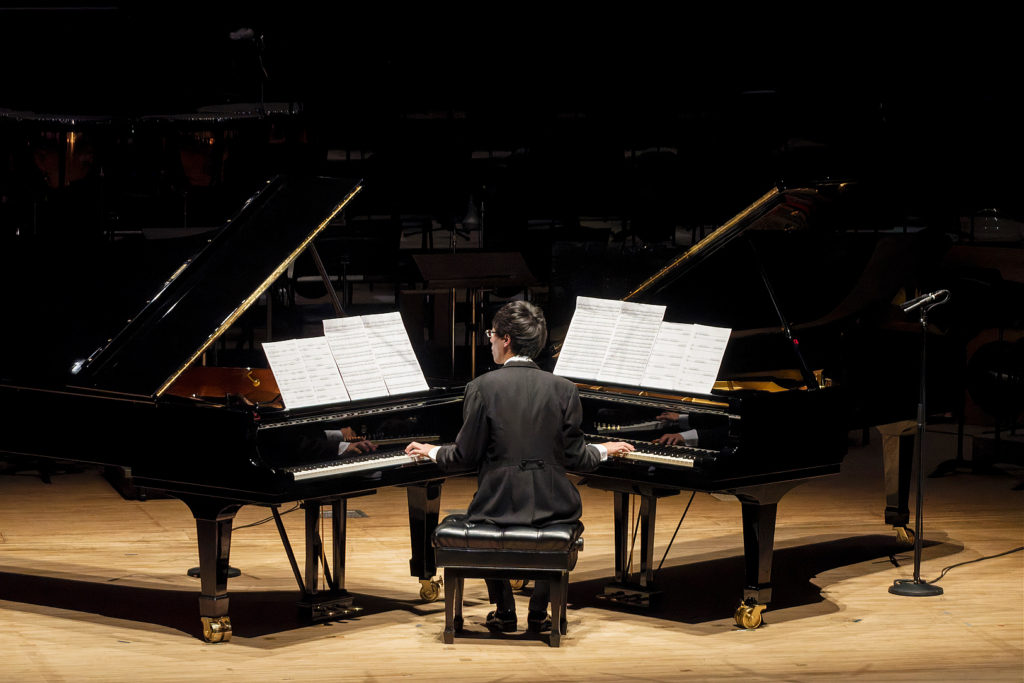
Performance scene Artificial Intelligence Art and Aesthetics Exhibition 2022 Georg Friedrich Haas《Hommage à Steve Reich》 Piano, quarter-tone piano: Tomoki Akiyama Photo by Ray Thoma, Courtesy of Artificial Intelligence Art and Aesthetics Research Group
It’s possible that, given the overabundance of artificial things in the present, our sensing of beauty in art tends toward a bias to sing the praises of humanity, before sensibilities even come into play. This became even clearer in the next program, when human performers finally appeared on stage and things started looking like they usually do at a concert. The program consisted of a series of performances by twin pianos tuned to normal and quarter tones. Although the official website included an amusing “warning” regarding the possibility of physical discomfort for those with absolute pitch (there was an actual doctor on standby), this piece felt very pleasant, perhaps due to it following the “baptism” of the self-playing piano. But this was still something that remained in the human sphere. As the mechanical sounds of Quarter-Tone Hanon for 2 Pianos, composed by AIAARG, coldly went about separating themselves ever further from so-called musical pleasure, I found myself reassured that this music is still within the realm of human understanding.
This resonates with the following utterance, made at the symposium held after the performance of the two pianos.
“We’re already getting to a point where only AI is capable of overseeing AI.”
The processing speed of artificial intelligences has become so enormous that they have already exceeded the scope of human intervention. So in the future, when both the artist and audience are AIs, the subject matter is likely to be beyond the realm of human appreciation. Our future will be one in which we will be grateful for the opportunity, provided by the kindness (?) of AI, to be shown simplified versions, dumbed down for the purpose of human understanding.
One daydreams of such things while listening to Ives’s Symphony No. 4. Precisely because we are far inferior to AI in terms of computational processing power, I’m convinced that only humans can create great art, the proof of our humanity. But what is this symphony? Because it was written by human hand, we try to decipher its intention, which leads to artistic pleasure. But if, say, it were written by an AI, even if it were the exact same piece of music, we would probably be relieved and exclaim, “This shows that it’s still impossible for an AI to understand the beauty of music.”
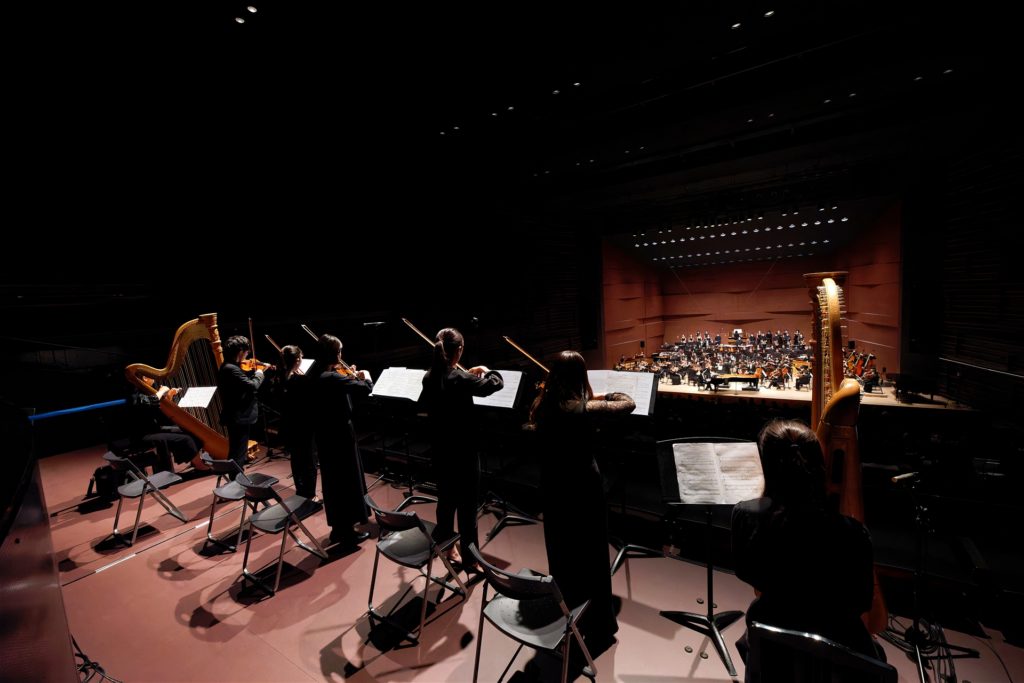
Performance scene Artificial Intelligence Art and Aesthetics Exhibition 2022 Charles Ives《Symphony No.4》 Photo by Hitoshi Iwakiri, Courtesy of Artificial Intelligence Art and Aesthetics Research Group
However, having come this far, I thought that Ives’s Symphony No. 4—the main dish— was merely an afterthought. I found myself listening to the astonishing second movement with more ease than I had expected. As I let myself be washed by a flood of stimuli that was too much to be described as mere dissonance, I felt as if I was peeking into the head of an AI engaged in musical deep learning. In the future, a sentient AI will surely provide all kinds of art for us foolish humans. AIs, with their all-encompassing data on the human organism and its behavior, will provide the most suitable art for each human being, much like a tailor-made dietary supplement. Then, people will stop trusting their own sensibilities and follow instead the prescriptions provided by AI. We will succumb to “the fact that I like that song is a good thing” sort of thinking, and human sensibilities will easily be rewritten in no time at all.
In a remarkable departure from the clamor of the previous parts, Ives’s Symphony No. 4 ends not with a mechanical fade-out, but strangely, like the flickering of a candle’s flame before it goes out, as if we are being shown a creature dying of natural causes. The end of this excessively radical work, which may have been made possible by Ives’s success as a businessman and the many extreme musical experiments that enabled, came to seem like a depiction of death. Not death in the narrative sense, but death as the phenomenon of an organic body gradually coming to a halt. And the unanswerable question arises:
“What does death mean to an AI?”
This event was too good to experience merely as a concert. Rarely has an art exhibition been able to provoke such thought about art and humanity.
Having completed the experience, I find that I spend more time thinking about the self-playing piano on the unmanned stage than Ives’s Symphony No. 4. My imagination conjures up a story of music created by a self-conscious AI, incomprehensible to humans. There are no human beings or any other lifeforms on stage or in the audience, only a large hall full of AIs. I want to listen to this music so badly, but the reason for the absence of my kind there may be due to the music being mentally disturbing to humans—or perhaps humans have already been eradicated, deemed useless by the AIs. Rather than a tragedy, this is a vision of the end point of the workings of the human self-consciousness, and—if you allow me—as such one of the most comprehensive artistic landscapes ever created by humankind.
Translated by Ilmari Saarinen
INFORMATION
Artificial Intelligence Art and Aesthetics Exhibition:
Is it the composer's fault that the performer has only 10 fingers?
Date: December 25, 2022
Venue : Parthenon Tama
【Art Exhibition】Main Hall Foyer
【Concert】Main Hall
Organized by: Artificial Intelligence Art and Aesthetics Research Group (AIAARG)
Under the sponsorship of: Charles Ives Society
Under the Auspices of: The Agency for Cultural Affairs “ARTs for the future! 2”


